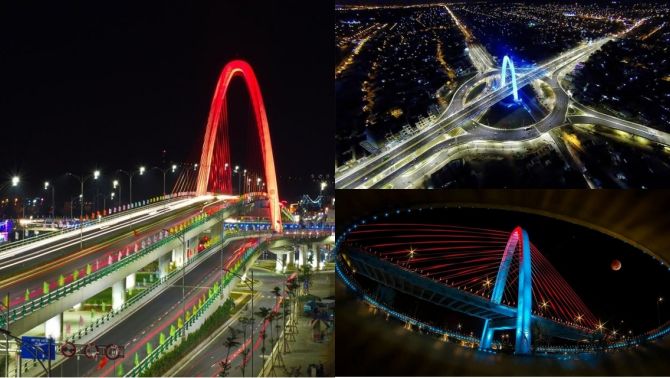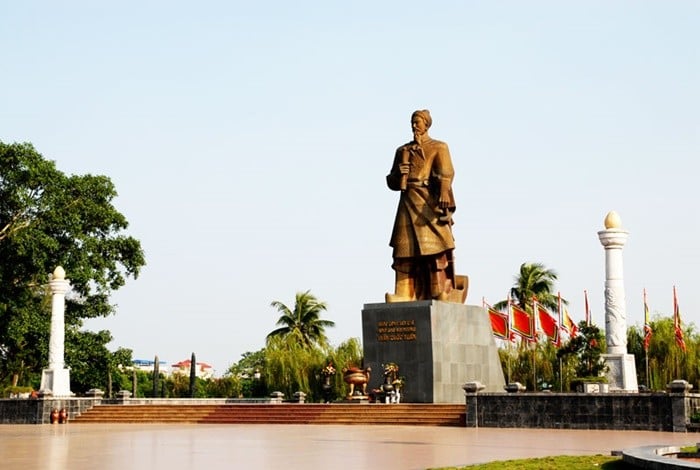Vietnam’s infrastructure has made significant strides, with many well-known projects being widely recognized. The first-ever three-tiered overpass in Vietnam is located in a place that few would think of, not in Hanoi or Saigon. It is considered an icon of modernity in the most livable city in Vietnam.
The First Three-Tiered Overpass in Vietnam

The overpass at the intersection of Hue has been under construction since March 29, 2013, with a total investment of nearly 2,051 billion VND. The project was approved by the Prime Minister under the Build-Transfer (BT Contract) form to implement the plan to reestablish the safety corridor of the railway, as approved in Decision No. 1856/QD-TTg of December 27, 2007.
After 18 months of construction, the project was completed and put into use in 2015 to celebrate the 40th anniversary of the Liberation Day of Da Nang City. This is a project that was organized for architectural selection with the participation of many consulting units with experience and capacity in designing bridges and roads both domestically and internationally.
The approved architectural plan for the intersection of Hue is influenced by the ancient Cham culture in the Da Nang area. The overall architectural concept of the intersection of Hue consists of parabolic-shaped tower columns and a surrounding circular roundabout, which features the stylized Linga and Yoni symbols of the deity Silva (the lord of all creatures), symbolizing the vitality and intense creativity of humanity.
This intersection is important not only for Da Nang but also for the three provinces: Da Nang, Quang Nam, Thua Thien – Hue. In the past, it was the only gateway to the Liên Chiểu district, the Hai Van Pass – a unique route to Hue from the center of Da Nang and Quang Nam. That is why the overpass is named “Hue Intersection.”
In addition, this road also has great significance for the North-South railway line. Every day, dozens of trains pass through the Hue intersection area. Before the construction of the three-tiered overpass, congestion occurred continuously whenever a train passed. Along with that, the traffic accident situation was also very troubling. With a height of up to 65m with three tiers of traffic and circular roundabouts with a diameter of up to 150m, the Hue Intersection overpass was considered the most modern structure in Vietnam at the time of its completion, establishing a record as the first three-tiered overpass in Vietnam. The completion of the Hue Intersection overpass has helped reduce congestion and traffic accidents on National Highway 1A where it intersects with the North-South railway line. It has also become an architectural highlight for the city, attracting tourism and commerce.
Some Iconic Urban Structures in Vietnam
+ Temple of Literature
The Temple of Literature is an iconic structure in Hanoi. The Temple of Literature (“gac ve dep cua sao Khue” in Vietnamese) is part of the Van Mieu – Quoc Tu Giam historical site, built in 1805 under the reign of King Gia Long of the Nguyen Dynasty. It is a small but uniquely architectured and high-value structure in terms of humanity and lofty ideas. The construction materials are wood and bricks, in the architectural style of the Nguyen Dynasty. The Temple of Literature and the Van Mieu – Quoc Tu Giam complex were recognized as Special National Monuments in 2012. The Temple of Literature is the official symbol of the capital city of Hanoi and appears on street signs in the inner city.
+ Hoa Binh Hydroelectric Plant
This is an iconic structure in Hoa Binh city in Hoa Binh province. The project commenced in 1979 and was completed in 1994 with the assistance of Soviet experts. This project marked the maturity of Vietnam’s industrialization and modernization path. At the time of completion, the Hoa Binh hydroelectric plant was the largest hydroelectric project in Vietnam and Southeast Asia. The image of the plant’s water dam has become the logo of Hoa Binh city’s street signs.
+ Viet Bac Museum
The Viet Bac Museum, now known as the Museum of History and Cultures of Vietnamese Ethnic Groups, is an iconic structure in Thai Nguyen city in Thai Nguyen province – a place known as the “capital of resistance”. The project was built in the 1960s by architect Hoang Nhu Tien, in a context where the North was “fighting and building” while the country was not yet unified. The Viet Bac Museum was the largest cultural project of its time. The project has high architectural value, combining modernity with ethnic characteristics. Currently, the Museum of History and Cultures of Vietnamese Ethnic Groups is one of the seven national museums and the only national museum not located in a major city.
+ Tran Hung Dao Statue

The statue is a new iconic structure in Nam Dinh city in Nam Dinh province. The Tran Hung Dao statue is located in Ba Thang Hai square, near Lake Vi Xuyen, in Nam Dinh city, which is the hometown of the Great General Tran Hung Dao. It is one of the most valuable artistic structures and a great success of outdoor sculpture in Vietnam in general and statue art in particular. The statue is cast in solid copper with a weight of about 21.6 tons, a height of 10.22m, and placed on a 6.5m high base. The design model of the statue was created by the painter and sculptor Vuong Duy Bien. The work was executed by Nguyen Phung Son Copper Casting Facility in Dong Nai province, starting in 1997 and completed in 2000. The Tran Hung Dao statue has become a top destination for visitors to Nam Dinh city. + Ham Rong Bridge
The Ham Rong Bridge spans the Ma River and is located on National Highway 1 North – South, representing the iconic structure of Thanh Hoa city and Thanh Hoa province as a whole. The bridge was started in 1962 and completed in 1964, replacing the old Ham Rong Bridge built by the French in 1904, which was destroyed during the war. This is a steel structure bridge for both road and railway. The Ham Rong Bridge is a magnificent symbol of the bravery of the people and troops of Thanh Hoa during the resistance war against the United States. This location was the main target of US airstrikes from the 1960s to the 1970s. At the Ham Rong Battlefield, the Vietnamese air defense and air force shot down more than 100 planes. In 1972, the bridge was bombed and collapsed, and it was rebuilt in 1973. Today, the Ham Rong Bridge is an invaluable historical monument and a top tourist attraction in Thanh Hoa city.






































